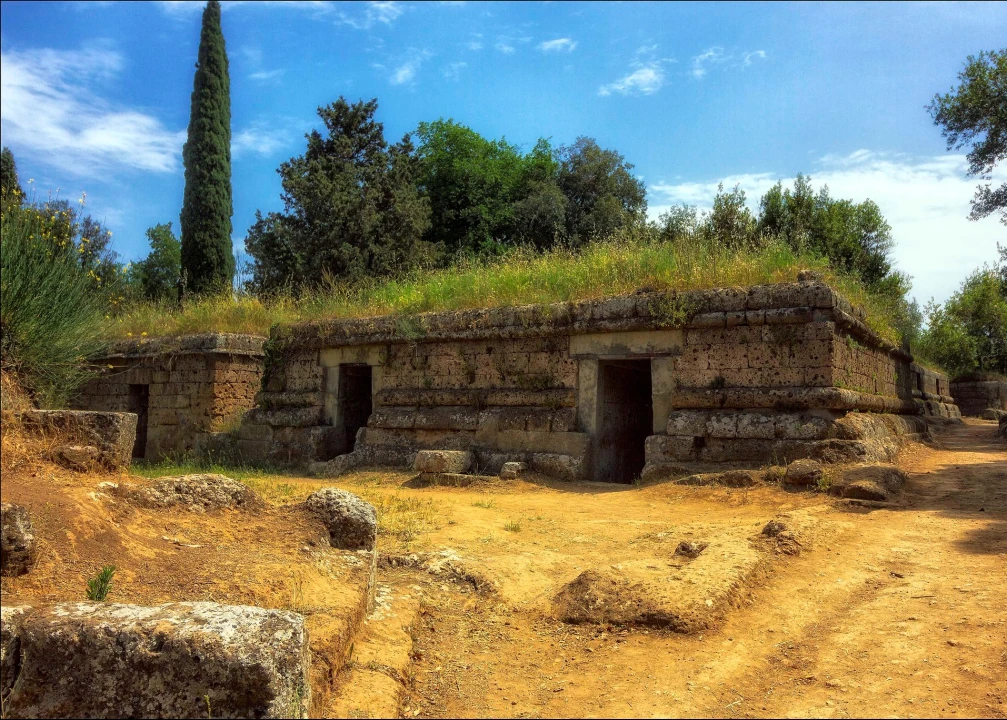The Necropolises of Cerveteri and Tarquinia, inserted onto the UNESCO World Heritage List in 2004, constitute a unique and exceptional testimoney of the ancient Etruscan Civilization, the only urban civilization of the pre-Roman Age. The frescoes inside the tombs – true-to-life reproductions of Etruscan homes – are faithful depictions of this disappeared culture’s daily life.
These tumuli or burial mounds reproduce the homes in their various types of constructions; because they were built to mirror the Etruscan habitation itself, they are the only examples left of such in any form anywhere. The two necropolises of northern Lazio are identical replications of the Etruscans' urban grid, and are among the primary exemplars of burial centers or hubs that one can find in Italy.
The necropolis of Banditaccia in Cerveteri was developed from the 9th Century B.C., and then expanded beginning with the 7th Century, following a well-defined urban plan. Similar is the developmental history of the necropolis of Monterozzi in Tarquinia.
Both the painted tombs of the nobles and those in more simple styles are singular and extraordinary testaments to Etruscan quotidian life, as well as their ceremonies, mythology and even their artistic capacities.
The Etruscans inhabited central-western Italy, between Tuscany and Lazio, from the 9th Century B.C., and experiencing a cultural climax around the 6th Century B.C. before completely disappearing - a result of the impact of Roman civilization, with which it merged in part.
No definite answer exists as to this people’s origins, and neither does any trace of a similar community – in regards to its ethnic and social characteristics – between Europe and Asia.
Cerveteri’s Necropolis
The necropolis tombs have very different traits one from the other, depending on the construction period and technique. Those located in the vast archaeological site of Cerveteri are in the thousands. Organized according to an urban plan that resembles that of a city with streets, piazzas and quarters (or neighborhoods), their typology differs in relation to the historical period and the status of the family to whom they belonged.
Among the most representative examples of these structures is the Tomb of the Greek Vases, dating back to the 6th Century, and accessible through a corridor that seems to imitate an Etruscan temple. The Tomb of the Cornice, rather, allows access by way of an incline walk that leads to two smaller rooms that hold funereal beds on each side. From there, the pathway continues to a large central room that itself connects to three other principal funerary rooms. Meanwhile, the Tomb of the Capitelli (or the Capitals of a column) owes its peculiarity to its flat roof that is an exact copy of that of the Etruscan home, with support beams of oak and reed.
Still, the most famous tomb – of the thousands at Banditaccia – is the Tomb of Reliefs, completed in the 4th Century B.C. It is accessible by way of a long stairway dug into the rock and running to a large room. Here, the ceiling is supported by two columns with capitals unique to Etruria. Thirteen matrimonial funerary niches fill the space, and are painted with red pillows, domestic objects and animals. It is a perfect cross section of a well-to-do Etruscan family of the 4th and 3rd Centuries.
The Necropolis of Tarquinia
The necropolis of Monterozzi in Tarquinia is also famous for its painted tombs, also dug into rock and accessible by means of inclined corridors or stairways. It was realized predominantly for one couple and is composed of one burial room. The first tombs were painted in the 7th Century, but it is only from the 6th Century that they were completely covered in frescoes.
Of the most famous, the Tomb of the Lionesses dates back to the 4th Century, and consists of a small room with a two-sloped roof. Here, the painting features birds flying and dolphins jumping around scenes of the Etruscan aristocracy. The Hunter’s Tomb, also 4th Century, is presented as the inside of a tent, a pavilion with a wooden support structure. The Tomb of Hunting and Fishing, then, is one of the best-known and most studied; composed of two rooms, the first is complete with a fresco of a Dionysian dance in a sacred wood, while the second offers a scene of the tombs' owners hunting and fishing.
In the Environs
The numerous visitors to the necropolises every year travel to the archaeological sites of Upper Lazio on excursion from their primary destination, the Eternal City, Rome, or during a stay in Tuscany or a trip to the thermal spas of Viterbo. This area is characterized by a rich enogastronomic and viticulture tradition, offering travelers a number of occasions in which to taste local products and typical dishes (e.g. the DOC Cerveteri Wine, or DOP Olive Oil from Canino) and to enjoy the entertainment (such as music, festivals) during summer and holidays.




